
The Ramayana is a smriti text from ancient India, one of the two important epics of Hinduism known as the Itihasas, the other being the Mahābhārata. The epic, traditionally ascribed to the Maharishi Valmiki, narrates the life of Rama, a prince of Ayodhya in the kingdom of Kosala. The epic follows his fourteen-year exile to the forest urged by his father King Dasharatha, on the request of Rama's stepmother Kaikeyi; his travels across forests in the Indian subcontinent with his wife Sita and brother Lakshmana; the kidnapping of Sita by Ravana, the king of Lanka, that resulted in war; and Rama's eventual return to Ayodhya along with Sita to be crowned king amidst jubilation and celebration.

Tamil literature has a rich and long literary tradition spanning more than two thousand years. The oldest extant works show signs of maturity indicating an even longer period of evolution. Contributors to the Tamil literature are mainly from Tamil people from south India, including the land now comprising Tamil Nadu, Kerala, Eelam Tamils from Sri Lanka, as well as the Tamil diaspora.

Cilappatikāram, also referred to as Silappathikaram or Silappatikaram, is the earliest Tamil epic. It is a poem of 5,730 lines in almost entirely akaval (aciriyam) meter. The epic is a tragic love story of an ordinary couple, Kannaki and her husband Kovalan. The Cilappatikaram has more ancient roots in the Tamil bardic tradition, as Kannaki and other characters of the story are mentioned or alluded to in the Sangam literature such as in the Naṟṟiṇai and later texts such as the Kovalam Katai. It is attributed to a prince-turned-monk Iḷaṅkõ Aṭikaḷ, and was probably composed in the 5th or 6th century CE.
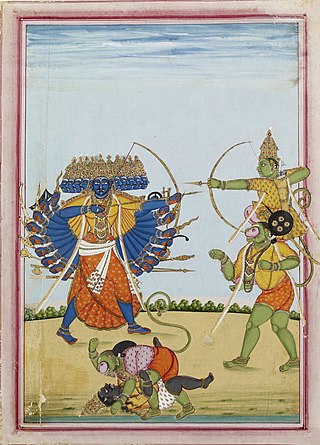
The Ramavataram, popularly referred to as Kamba Ramayanam, is a Tamil epic that was written by the Tamil poet Kambar during the 12th century. Based on Valmiki's Ramayana, the story describes the legend of King Rama of Ayodhya. However, the Ramavataram is different from the Sanskrit version in many aspects – both in spiritual concepts and in the specifics of the storyline. This historic work is considered by both Tamil scholars and the general public as one of the greatest literary works in Tamil literature.
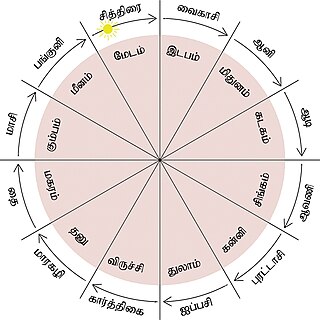
The Tamil calendar is a sidereal solar calendar used by the Tamil people of the Indian subcontinent. It is also used in Puducherry, and by the Tamil population in Sri Lanka, Malaysia, Singapore, and Mauritius.

Perumal or Tirumal is a Hindu deity. Perumal is worshipped mainly among Tamil Hindus in South India, Sri Lanka, and the Tamil diaspora, who consider Perumal to be a form of Vishnu.
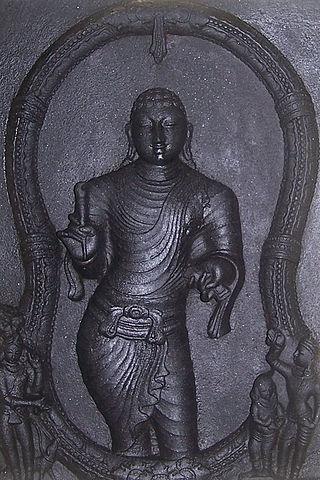
Ilango Adigal was a monk and a poet, sometimes identified as a Chera prince. He is traditionally credited as the author of Cilappatikaram, one of the Five Great Epics of Ancient Tamil literature. He is one of the greatest poets from Cheranadu. In a patikam (prologue) to the epic poem, he identifies himself as the brother of a famous Chera king Ceṅkuṭṭuvan (Senguttuvan). This Chera king, as stated by Elizabeth Rosen, ruled over his kingdom in late 2nd or early 3rd century CE. However, this is doubtful because a Sangam poem in Patiṟṟuppattu – the fifth ten – provides a biography of Ceṅkuṭṭuvan, his family and rule, but never mentions that he had a brother who became an ascetic or wrote one of the most cherished epics. This has led scholars to conclude that the legendary author Ilango Adikal myth was likely inserted later into the epic. In a 1968 note, Kamil Zvelebil suggested that, "this [Adigal claim] may be a bit of poetic fantasy, practised perhaps by a later member of the Chera Dynasty [5th or 6th century] recalling earlier events [2nd or 3rd century]".

Sri Ranganathaswamy Temple is a Hindu temple dedicated to Ranganatha, located in Srirangam, Tiruchirapalli, Tamil Nadu, India. Constructed in the Dravidian architectural style, the temple is glorified by Alvars in their Naalayira Divya Prabhandam and has the unique distinction of being the foremost among the 108 Divya Desams dedicated to the god Vishnu.

Karikala often referred to as Karikala the Great was a Tamil king of the Early Cholas of the Chola dynasty who ruled ancient Tamilakam from Uraiyur. He is credited with the construction of the flood banks of the river Kaveri. He is recognised as the greatest of the Early Cholas. In Thiruvalangadu plates of Rajendra Chola I, Medieval Tamil Cholas listed Karikala Chola as one of their ancestors. In Malepadu plates of Renati Chola king Punyakumara, Telugu Cholas claimed that they belong to the family of Karikala Chola and praises him for stopping the overflow over the banks of river Kaveri. Kakatiya king Ganapati-deva's Garavapadu charter traces the family's ancestry to Durjaya, a descendant of Karikala Chola who arrived at a town called Kakati during a hunting expedition, and set up his camp there.Many other Telugu dynasties also claimed descendant from Karikala Chola.

Killivalavan was a Tamil king of the Early Cholas mentioned in Sangam literature, and of a period close to that of Nedunkilli and Nalankilli. We have no definite details about this Chola or his reign. The only information we have is from the fragmentary poems of Sangam in the Purananuru.

Nainativu, is a small but notable island off the coast of Jaffna Peninsula in the Northern Province, Sri Lanka. The name of the island alludes to the folklore inhabitants, the Naga people. It is home to the Hindu shrine of Nagapooshani Amman Temple; one of the prominent 64 Shakti Peethas, and the Buddhist shrine Nagadeepa Purana Viharaya.
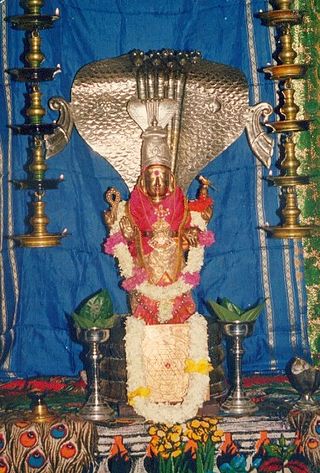
The Naga people are believed by some to be an ancient tribe who once inhabited Sri Lanka and various parts of Southern India. There are references to Nagas in several ancient texts such as Mahavamsa, Manimekalai, Mahabharata and also in other Sanskrit and Pali literature. They were generally represented as a class of super-humans taking the form of serpents who inhabit a subterranean world.

The Adi Jagannatha Temple is a South Indian Hindu temple in Thiruppullani, a village in the outskirts of Ramanathapuram in the South Indian state of Tamil Nadu, is dedicated to the Hindu god Vishnu. It is believed that Rama used grass ('pul' in Tamil as a pillow to sleep and hence the village attained the name Thiruppullani. Constructed in the Dravidian style of architecture, the temple is glorified in the Naalayira Divya Prabandham, the early medieval Tamil canon of the Alvar saints from the 6th–9th centuries CE. It is one of the 108 Divya Desam dedicated to Vishnu, who is worshipped as Adi Jagannatha and his consort Lakshmi as Padmasini.
Maṇimēkalai, also spelled Manimekhalai or Manimekalai, is a Tamil-Buddhist epic composed by Kulavāṇikaṉ Seethalai Sataṉar probably somewhere between the 2nd century to the 6th century. It is an "anti-love story", a sequel to the "love story" in the earliest Tamil epic Silappadikaram, with some characters from it and their next generation. The epic consists of 4,861 lines in akaval meter, arranged in 30 cantos.

Thirupullabhoothangudi Temple is a Hindu temple dedicated to Vishnu located in Pullabhoothangudi near Kumbakonam in the South Indian state of Tamil Nadu. Constructed in South Indian Style of Architecture, the temple is glorified in the Nalayira Divya Prabandham, the early medieval Tamil canon of the Alvar saints from the 6th–9th centuries CE. It is counted as one among the 108 Divya Desams dedicated to Vishnu. Vishnu is worshiped as Valvil Ramar and his consort Lakshmi as Sita.
Hinduism in Tamil Nadu finds its earliest literary mention in the Sangam literature dated to the 5th century BCE. The total number of Tamil Hindus as per 2011 Indian census is 63,188,168 which forms 87.58% of the total population of Tamil Nadu. Hinduism is the largest religion in Tamil Nadu.
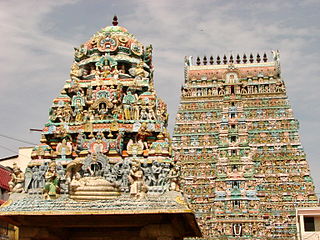
Tamil Nadu is known for its ancient temple architecture. Nearly 33,000 ancient temples, many at least 800 to 2000 years old, are found scattered all over Tamil Nadu. As per Tamil Nadu Hindu Endowments Board, there are 38,615 temples. Most of the largest Hindu Temples reside here. Studded with complex architecture, a variety of sculptures, and rich inscriptions, the temples remain the very essence of the culture and heritage of Tamil land, with historical records dating back to at least 3,000 years.

Vijayaraghava Perumal temple is a Vishnu temple in Thiruputkuli, a village in Kanchipuram district in Tamil Nadu, India. It is situated about 7 miles west of Kanchipuram and half a kilometre from Baluchetti Chattiram, which lies on the Chennai - Vellore highway. Constructed in Dravidian style of architecture, the temple is glorified in the Naalayira Divya Prabandham, the early medieval Tamil canon of the Alvar saints from the 6th–9th centuries CE. It is counted as one among the 108 Divya Desams dedicated to Vishnu. Vishnu is worshiped as Vijayaraghava Perumal and his consort Lakshmi as Maragathavalli Thayar.

Vaishnavism in Ancient Tamilakam is one of the major Hindu denominations. It is also called Perumalium since it considers Perumal as the sole supreme being leading all other Hindu deities, i.e. Mahavishnu. Its followers are called Vaishnavites or Vaishnavas, and it includes sub-sects like Krishnaism and Ramaism, which consider Krishna and Rama as the supreme beings respectively. According to a 2010 estimate by Johnson and Grim, Vaishnavism is the largest Hindu sect, constituting about 641 million or 67.6% of Hindus. Vaishnavism in Tamil Nadu finds its earliest literary mention in the Sangam literature dated to the 5th century BCE. Maha Vishnu or Perumal is considered as the most mentioned god in the Sangam Literature. Some of the earliest known mentions of Perumal, and the Tamil devotional poems ascribed to him, are found in Paripāṭal – the Sangam era poetic anthology. He is a popular Hindu deity particularly among Tamils in Tamil Nadu and the Tamil diaspora, and in Vaishnava temples. One of the richest and largest Hindu temples complexes dedicated to Perumal in South India.
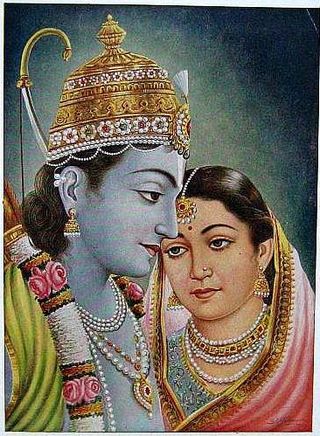
The Rama Natakam is a Tamil Opera that was written by the Tamil poet Arunachala Kavi also known as Arunachala Kavirayar during the 18th century. Based on Kambar's and Valmiki's Ramayana, the opera describes the legend of King Rama of Ayodhya. The Rama Natakam is even more similar to the Tamil version than the Sanskrit version in many aspects – both in spiritual concepts and in the specifics of the storyline. Several songs of this opera are well known and sung all over Tamil Nadu. Arunachala Kavirayar studied Sanskrit and Tamil in the Dharmapuram Adheenam and excelled in his studies. After his marriage he set up a pawn-broker shop, This not only provided him with a good living, but also with a fair amount of Leisure to pursue his literary studies. Just as he was good at “estimating the fineness of the precious metal, he was equally proficient at estimating the worth of the literary works.” Two books were most liked by Kavirayar — The Tirukkural of Tiruvalluvar and the Ramavataram of Kambar, While the former was only a book of ethics, the latter gave the same in the form of a story which would be more appealing to the common man.





















